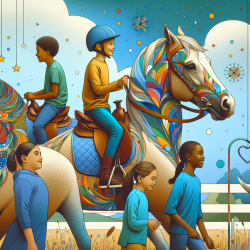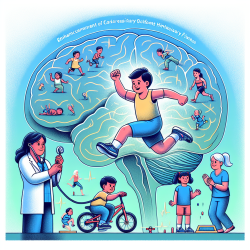Fun and Easy Reading: Implementing Therapeutic Horseback Riding for Children with Autism

As a therapist working in an educational setting, I am always on the lookout for innovative and effective interventions to help children with autism spectrum disorder (ASD). One such intervention that has been gaining attention is Therapeutic Horseback Riding (THR). A recent research article, "Replication Pilot Trial of Therapeutic Horseback Riding and Cortisol Collection With Children on the Autism Spectrum," provides compelling evidence for the benefits of THR.In this study, children with ASD participated in a 10-week THR program, and the outcomes were compared to a control group that engaged in non-horse-related barn activities. The results showed significant improvements in hyperactivity and social awareness for the THR group. Additionally, there were improvements at the 0.1 significance level in irritability and social communication behaviors.The study also explored the physiological effects of THR by measuring salivary cortisol levels, a biomarker for stress. Interestingly, children who had lower levels of hyperactivity and irritability before the THR sessions showed greater reductions in cortisol levels after the sessions. This suggests that THR may help regulate stress levels in children with ASD.Here are some key takeaways for practitioners looking to implement THR:
- Significant Behavioral Improvements: THR participants showed marked improvements in hyperactivity and social awareness. This can lead to better classroom behavior and social interactions.
- Stress Reduction: Measuring salivary cortisol levels revealed that THR could help reduce stress in children with ASD, making them more receptive to learning and other therapeutic interventions.
- Structured Environment: The study emphasized the importance of a structured environment with consistent routines, visual schedules, and concrete visual cues. This approach can enhance the effectiveness of THR.
- Replication and Further Research: The study calls for more methodological standardization and replication to confirm the efficacy of THR. Practitioners are encouraged to contribute to this growing field by conducting further research.
To read the original research paper, please follow this link:
Replication Pilot Trial of Therapeutic Horseback Riding and Cortisol Collection With Children on the Autism Spectrum.By incorporating these findings into your practice, you can help improve the lives of children with ASD. Remember, every small step towards better understanding and implementing effective interventions can make a significant difference.
Citation: Pan, Z., Granger, D. A., Guérin, N. A., Shoffner, A., & Gabriels, R. L. (2019). Replication Pilot Trial of Therapeutic Horseback Riding and Cortisol Collection With Children on the Autism Spectrum. Frontiers in Veterinary Science, 5, 312. https://doi.org/10.3389/fvets.2018.00312










